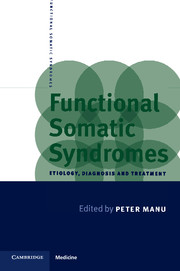Book contents
- Frontmatter
- Contents
- List of contributors
- Preface
- 1 Definition and Etiological Theories
- 2 Chronic Fatigue Syndrome
- 3 Fibromyalgia Syndrome
- 4 Irritable Bowel Syndrome
- 5 Premenstrual Syndrome
- 6 Interstitial Cystitis
- 7 Temporomandibular Disorders
- 8 Chest Pain Syndromes
- 9 Repetitive Strain Injury
- 10 Multiple Chemical Sensitivities
- 11 Psychopharmacology of Functional Somatic Syndromes
- 12 Psychotherapy of Functional Somatic Syndromes
- 13 Determination Of Disability Claimed By Patients With Functional Somatic Syndromes
- 14 Functional Somatic Syndromes: Exploring Common Denominators
- Index
6 - Interstitial Cystitis
Published online by Cambridge University Press: 08 January 2010
- Frontmatter
- Contents
- List of contributors
- Preface
- 1 Definition and Etiological Theories
- 2 Chronic Fatigue Syndrome
- 3 Fibromyalgia Syndrome
- 4 Irritable Bowel Syndrome
- 5 Premenstrual Syndrome
- 6 Interstitial Cystitis
- 7 Temporomandibular Disorders
- 8 Chest Pain Syndromes
- 9 Repetitive Strain Injury
- 10 Multiple Chemical Sensitivities
- 11 Psychopharmacology of Functional Somatic Syndromes
- 12 Psychotherapy of Functional Somatic Syndromes
- 13 Determination Of Disability Claimed By Patients With Functional Somatic Syndromes
- 14 Functional Somatic Syndromes: Exploring Common Denominators
- Index
Summary
Interstitial cystitis (IC) is a chronic debilitating disorder affecting primarily females. It is characterized by pain in the region of the bladder and pelvic musculature, and variable motor and sensory dysfunctions of the bladder. There is currently no consensus regarding the unique clinical, endoscopic or histological features of IC. Diagnosis is typically based on the patients' symptomatology, urological evaluation, including cystoscopy and histopathological findings, and the exclusion of other recognizable bladder diseases. The most prevalent symptoms of IC are urinary frequency, urgency, and suprapubic, pelvic or perineal pain. Although the etiology of this disease remains obscure, putative causative agents include infection, vascular or lymphatic obstruction, neurogenic, endocrinological or inflammatory causation, autoimmune reactions, dysfunction of the bladder mucus and the presence of toxic substances in the urine. As it is a syndrome, perhaps several etiologies are operating. The wide range of treatment modalities also reflects this lack of etiological clarity. The majority of patients can expect relief of their symptoms to varying degrees, even though treatment is frequently nonspecific and noncurative.
The direct medical costs for diagnosis and treatment, as well as the indirect costs due to significant work disability and other limitations of patient functional status, are potentially large. Yet no systematic studies of the costs of illness for interstitial cystitis have been published.
History
Inflammations present in the bladder wall of female patients were depicted as transmural or ‘interstitial’ cystitis (IC) by Skene (1878) in a monograph on female bladder and urethral disease.
Keywords
- Type
- Chapter
- Information
- Functional Somatic SyndromesEtiology, Diagnosis and Treatment, pp. 98 - 126Publisher: Cambridge University PressPrint publication year: 1998



